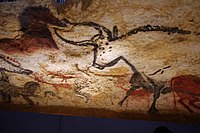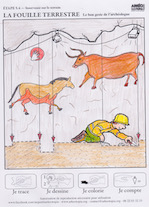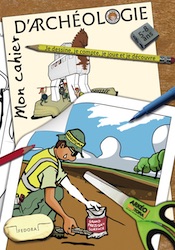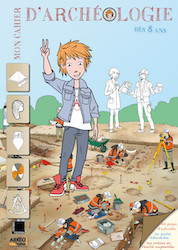What is an Archaeological Excavation?
- Last Updated: Tuesday, 28 June 2022 09:23
- Published: Friday, 15 April 2022 09:21
- Written by Jean-Olivier Gransard-Desmond translated by Leah Gallet
- Hits: 1614
Join Augustin, Alex, Lisa and the whole ArkeoTopia team to discover additional resources for step 5.4 in My Archaeology Book about excavation, or more specifically land-based excavation, one of many methods used in archaeology.
Step 5.4 — Fieldwork
Archaeological Land-Based Excavation
Corresponding pages in MAB1 and MAB2
MAB 1, p. 18 and MAB 2, p. 24
More about this step’s reference artifact
The drawing in My Archaeology Book titled Archaeological Land-Based Excavation was inspired by the Lascaux cave in Dordogne. Archaeological digs are the most well-known aspect of all of the work done by archaeologists. Excavation, however, is actually only one of a great number of activities that fall under the umbrella of what constitutes archaeology.
 Just a few short months after its discovery on September 12, 1940, the Lascaux Cave was designated a national historic site (monument historique in France) on December 27, 1940. The site has been recognized as a UNESCO World Heritage Site since October 1979, along with a number of other prehistoric sites and decorated caves of the Vézère River valley. Lascaux has been dated to around 15,000 BCE — during the late Salutrean/early Magdalenian period. It offers a substantial assortment of the iconography of Magdalenian artists: aurochs, bison, horses, deer, bears, symbols, an avian creature. An aurochs and a horse are the only figures pictured in this section (Step 5.4) to represent the extensive collection of iconography found in the cave. Although no negative handprints were found at Lascaux, one is included here as this technique is very popular in elementary school teachings.
Just a few short months after its discovery on September 12, 1940, the Lascaux Cave was designated a national historic site (monument historique in France) on December 27, 1940. The site has been recognized as a UNESCO World Heritage Site since October 1979, along with a number of other prehistoric sites and decorated caves of the Vézère River valley. Lascaux has been dated to around 15,000 BCE — during the late Salutrean/early Magdalenian period. It offers a substantial assortment of the iconography of Magdalenian artists: aurochs, bison, horses, deer, bears, symbols, an avian creature. An aurochs and a horse are the only figures pictured in this section (Step 5.4) to represent the extensive collection of iconography found in the cave. Although no negative handprints were found at Lascaux, one is included here as this technique is very popular in elementary school teachings.
While digs may be best-known as an archaeological method, archaeologists are not the only professionals who perform land-based excavations. Paleontologists that study dinosaurs also organize digs. Their subject of study, however, is entirely different from that of archeologists, despite the confusion often fostered by the media and in schools. Paleontologists study the fossils of living beings, whereas archaeologists study human History as understood through the evolution of human technical abilities.
In archaeology, excavation is divided into two main categories: research excavation and development-led or rescue excavation. The former, whether on land or underwater, is driven by professional research goals aimed at contributing to the greater knowledge base. In contrast, development-led or rescue excavations are fueled by the desire to preserve archaeological remains that would otherwise be destroyed by public or private construction projects. Where research excavations are concerned, archaeologists have all the time they need to study the site without pressure to be finished by a certain date. In the case of development-led excavation, however, time constraints can often make timelines for excavation very short, and sometimes even render data collection impossible. These hastened timelines can result in excavation processes that lack thoroughness and miss certain details that are important to fully understanding the findings, information that is ultimately lost forever as it is not integrated into the final results.
As far as tools are concerned, the best method for archaeologists to maneuver the trowel in both research and rescue excavations is with a sweeping gesture performed directly in front of them. The trowel is used to carefully rake the earth towards them, as demonstrated in the video to the right. Depending on the environment and the civilization under study, archaeological digs are organized accordingly. Here we will explain what is involved in the excavation of a cave. As opposed to drawing a grid on the ground, the lines of the grid are created using strings suspended from the cave ceiling. The strings are weighted as plumb lines to ensure the verticality of the lines. In order to facilitate the work of archaeologists in dark cave conditions, lights are also installed on the ceiling and powered by a generator (not visible here).
Depending on the environment and the civilization under study, archaeological digs are organized accordingly. Here we will explain what is involved in the excavation of a cave. As opposed to drawing a grid on the ground, the lines of the grid are created using strings suspended from the cave ceiling. The strings are weighted as plumb lines to ensure the verticality of the lines. In order to facilitate the work of archaeologists in dark cave conditions, lights are also installed on the ceiling and powered by a generator (not visible here).
The unevenness of the excavation site here shows that delineating a site does not necessarily make it uniform, as some spaces require more intensive clearing than others. Archeologists clear a square grid of a dig site using a special kind of trowel. This tool has a specific diamond shape, which is useful both when employing the back of the trowel to do more flat soil stripping or when holding the trowel on its side in order to work perpendicular to the ground. Here, Alex the archaeologist, wearing a helmet and reflective clothing to ensure his safety, is digging at an angle perpendicular to the layer where he has unearthed a flint.
Clues
The idea here is to understand what a dig looks like as well as which tools archaeologists use on-site at an excavation.
The 14 clues include:
- The lights used to illuminate the excavation
- The plumb lines hanging from the cave ceiling
- An aurochs painted by Magdalenians
- A horse painted by Magdalenians
- A negative handprint made by Magdalenians
- The various grid squares of the dig
- Alex, the archaeologist
- Alex’s helmet and clothing
- Alex’s diamond shape trowel
- Alex’s position, kneeling on the ground
- The flint Alex has unearthed
- The small mound of earth in front of Alex’s knees
- The cave ceiling
- The ground Alex has excavated, as seen in cross-section
Underwater ExcavationMy Archaeology Book
Resources HomepageStep 5.5 - Fieldwork
Taking Pictures
 |
 |
|
My Archaeology Book 1 |
My Archaeology Book 2 |

 My Archaeology Book, or MAB, is an activity workbook that combines creativity, fun and learning. Alongside young Augustin, a curious and courageous boy, children meet Alex and Lisa, two friendly archaeologists who will lead them to discover archaeology and French heritage. Each drawing illustrates a situation that Alex and Lisa might encounter at work. Depending on the age of the child and the workbook, children follow easy-to-understand symbols in order to experiment with activities such as coloring, drawing, observation games, riddles and reading in order to see the world through an archaeologist’s eyes. Alone, with family, at school or just for fun, children expand their knowledge and gain skills, all while having fun.
My Archaeology Book, or MAB, is an activity workbook that combines creativity, fun and learning. Alongside young Augustin, a curious and courageous boy, children meet Alex and Lisa, two friendly archaeologists who will lead them to discover archaeology and French heritage. Each drawing illustrates a situation that Alex and Lisa might encounter at work. Depending on the age of the child and the workbook, children follow easy-to-understand symbols in order to experiment with activities such as coloring, drawing, observation games, riddles and reading in order to see the world through an archaeologist’s eyes. Alone, with family, at school or just for fun, children expand their knowledge and gain skills, all while having fun.
On this section, you will find additional resources: color photos of archaeological documents that inspired My Archaeology Book, additional teaching documents (flip-book, websites, suggestions for classroom use, edutainement, etc.) and information on upcoming publications. Each page will be updated over time.







